B2B Keyword Research: The cornerstone of B2B SEO
We think keyword research is the cornerstone of a B2B digital marketing strategy in 2021. This is because a digital strategy is often focused around SEO & content marketing. When there are so many companies competing for the attention of the same audience and all the businesses are looking for the cheapest way to attract leads, gaining traffic through inbound marketing tactics and specifically content marketing is very popular.

Year-over-year growth in unique site traffic is 7.8x higher for content marketing leaders compared to followers (19.7% vs 2.5%).
(Source: Aberdeen)
It’s no co-incidence tools like HubSpot have become widespread in B2B software companies. It’s also why content marketing has become the mantra of any CMO or Head of Marketing we encounter.
Most B2B content is never read
Because everyone is doing the same thing the internet is crowded for content all on the same topic. Like this article on keyword research, there are thousands of similar articles on the internet. Some of it is just people churning things out for the sake of it, some of it can be really well written and insightful, but nobody is looking for it – it’s an opinion piece.
According to Sirius Decisions, 60–70% of B2B content created goes unused.
So why are you reading this one?
If you found this article through Google you were probably searching for something relating to B2B keyword research, or something relating to niche keyword research for B2B companies (hopefully). How did we do it? Well through the very tactic we are going to be talking about – so, the proof is in the pudding.
What is B2B keyword research?
Well, for a start keyword is a bit of a misleading term. From our point of view as a b2b digital marketing agency, a keyword is anything someone types into a search engine with the aim of finding something. It’s the same thing as a search term or search query.
An example of a keyword for this article would be: “Keyword research” or “B2B keyword research”. Obviously there is more than one word there and these phrases or searches can actually get to be fairly long.
The rule of thumb is that, in general, the longer the keyword the fewer searches there are for these terms as the search becomes more and more specific (makes sense right?). For example: “keyword research tools for software companies”. This is a long and niche keyword that’s not as common as “keyword research” so there is likely to be fewer people typing this in.
There is a term used to refer to these longer more specific searches, it’s called long-tail search queries. And in fact, long-tail searches account for the majority of internet searches, because people are looking for specific things. I think this has increased over time as the internet has become saturated with content and people know Google will pretty much have an answer to almost anything they type in, they expect it to have the answer. There’s an interesting book called the big 4 which talks about this a little bit.

What’s the point of keyword research?
Ok, let’s take a step back and consider what the point of this is. The point, in my opinion (as a digital marketer or marketeer?), of keyword research, is to discover what people are searching for online and match your digital content to those searches in a way that is relevant to your product and services and their needs.
The end goal is to increase the amount of website traffic that ends up on your website. Of course, this traffic needs to relevant to your business, and the content on your site needs to be relevant to your audience. This traffic can then be converted into leads which can in turn be turned into customers.
Content marketing costs 62% less than traditional marketing and generates about 3 times as many leads.
(Source: DemandMetric)
Pragmatic Content vs Idealistic Content
An idealistic content marketer will write about grand thought leadership pieces that set you apart from the crowd and prove your superior foresight and intelligence over the competition. This is an important part of B2B content marketing, especially in a crowded market and even more so when your brand is established and well known, but it’s more relevant to enterprise b2b tech businesses rather than scale-ups or start-ups, who cares what the new kid on the block thinks?

What I call pragmatic content marketing is content that is produced to serve your business goals, i.e. make money. From our experience as a B2B digital marketing agency, the goals for the business usually relate to generating qualified leads. This is why inbound marketing has become so popular, and effective. It’s essentially based around producing really useful content that draws people to your website. At which point you direct them towards submitting their details in exchange for some more information or a service, sound boring or a lot of effort? Well, unfortunately, there’s no shortcut for some things.
So where does keyword research fit into this? If your goal is to generate more relevant traffic through producing content that attracts visitors that are likely to convert, you need to discover what those people are looking for online. This is where understanding the stages of awareness come in to play.
B2B Buyer awareness stages
It’s important to understand that not everyone knows you exist. Or even know they have the problem you are solving exists, nevermind that there is a solution to it and by the way, there’s lots of them and yours is the best one for them.
B2B content marketing needs to address all these stages, content and SEO play an important part in the early stages of this ‘awareness journey’ if we are going to call it something. Each stage has a slightly different type of keyword research that needs to be done to make sure your site is optimised and you attract as many different visitors as possible.
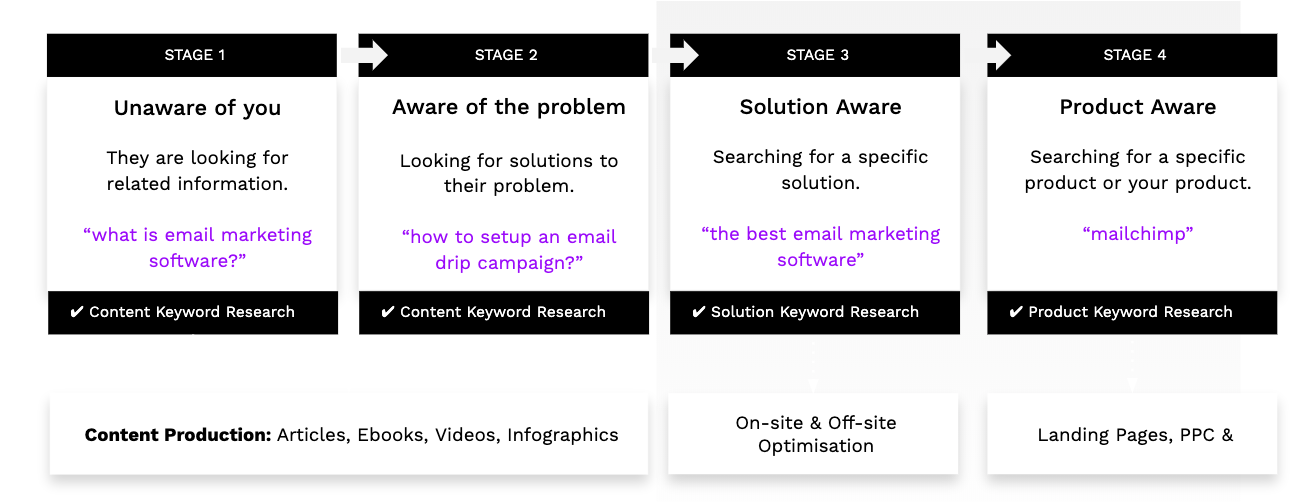
Unaware
These web users are blissfully unaware of the problems they may or may not already have. They are at the first stage of their enlightenment journey to discover something for the first time.
To use Clarity Performance (a b2b digital marketing agency) as an example. These types of users for us would be searching for results using terms like “what is digital marketing” or “what is b2b digital marketing”. You could argue they are aware if they are searching for these terms but the point is they are unaware of you and your solution.
Usually, these types of keywords or long-tail terms are questions rather than statements. Below is an example taken from SEMRush’s Keyword Magic Tool (this is the main tool we use for our SEO projects).
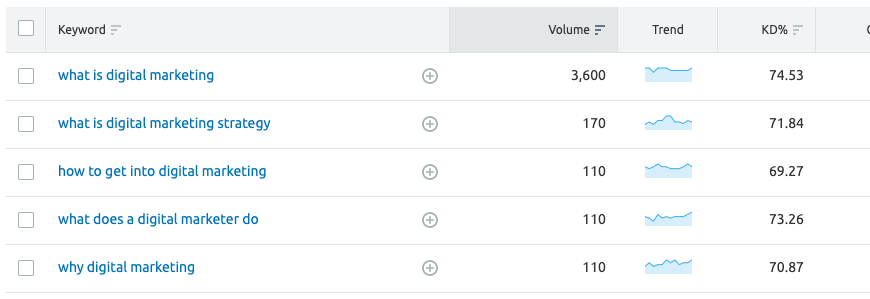
The volume is the number of monthly searches (on average) in the UK alone for that term. KD% is an estimate of how difficult it would be for someone to rank highly for this key term. It’s a rough estimate but it gives you an idea of how competitive the term is.
Writing content for these searches means answering these questions. A lot of websites take the FAQ approach to this and most will produce a long piece of blog content that answers all of these similar questions in one go – the key is to be as useful and easy to digest as possible.
Problem aware
People who are aware of the problem are looking for solutions, again for us, it may be something like “how to increase website leads” or “how to improve my Google rankings”. These are long-tail searches that are quite specific and they are again mainly questions. They also relate to specific B2B SEO services we offer so it is aligned with a business goal for us.

Based on this example you may write an article titled “How to increase your website traffic” which provides lots of options and useful ideas for this.
Solution aware
Solution aware web users are those who are aware of the different solutions to the problems they face but are looking for the best solution. Again here are some examples below. There is a slight difference here between being aware of the solution and choosing the right one, usually, this is called the consideration phase of a B2B buyer journey.
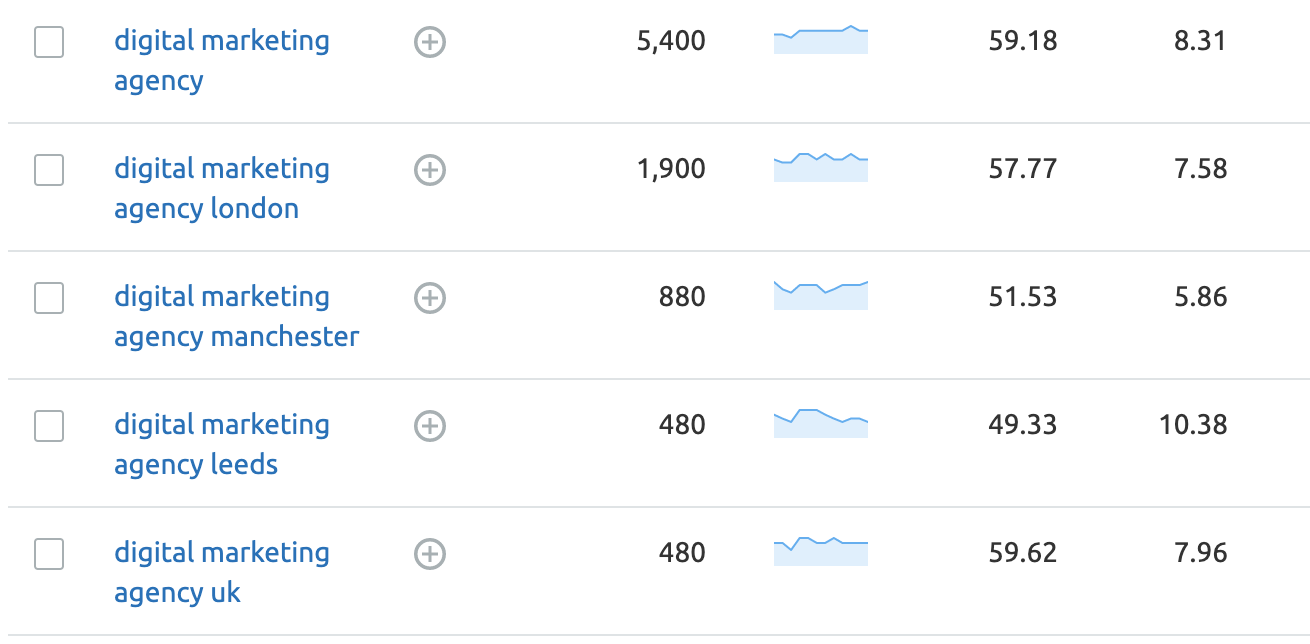
A consideration search query may look something more like the below:

Typically solution keyword research is the common part of keyword research and often the part too many companies focus on. They are worried about where they rank for “digital marketing agency” but what they don’t realise is this is only one small section of the audience they could be reaching. It’s also often the hardest one to rank for even the difficulty can be low sometimes.
We recommend mapping solution search terms to pages on your website like your homepage and your product and services page. Then when you write a content piece you use those keywords as anchor text to link to the product or service like we might do with the term B2B SEO. < like that.
SEO best practice note here, we recommend optimising each page on your website for one term and one term only.
The simple trick behind more traffic
Keyword research is an important part of b2b digital marketing and of course an important part of B2B SEO. It’s not so relevant (IMO) for e-commerce. SEO used to be some hacker type thing that people would use to trick search engines to think their site was the most relevant to the user. Those days a long gone, and SEO as a practice is basically just making sure your website is more useful for your target audience than anyone else’s website.
Google’s algorithms are getting smarter and more human-like with every year. Google is also serving up more answers in the actual search results page than it used to. Especially for simple questions like in the screenshot below.
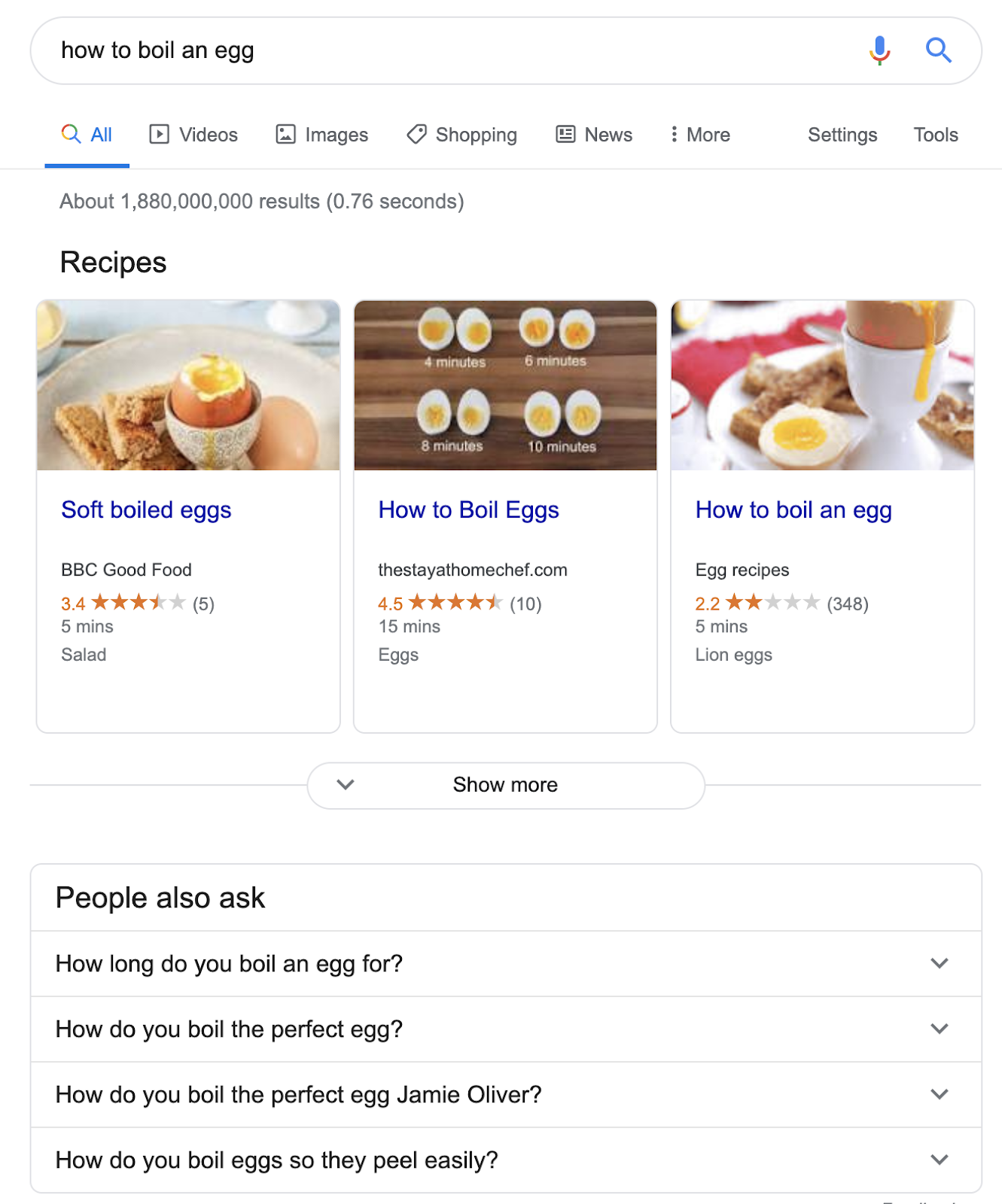
Some of the professional SEO community are worried about this type of thing because it means Google is not sending people to the websites it’s just collating the content in the search results from the website.
What some SEO experts forget is that Google is a service. They are trying to provide the best service possible and make it as easy as possible to find the answer to any question. Ironically UX designers will always say that reducing the number of steps or clicks to important information is key, so why when Google do it is it a big problem?
Showing up in these answer boxes is another thing and it really comes down to best practice web design, content formatting and a site this widely regarded as relevant and useful.
So, bearing this in mind. Producing useful B2B content, we believe, is the cornerstone of B2B SEO. But the trick to succeeding with this tactic is finding the keywords that are relevant, have some monthly volume but are also not too difficult to rank for.
The key to making it work for you
In a nutshell, you need to find low difficulty relevant long-tail key terms.
The principle is this, if there are 1 million articles online written about topic A and 100 written about topic B, it’s going to be easier to rank highly for topic B. You are plugging gaps in Google’s database, you’re helping them serve the users better.
Once you have built up a bulk of content around these lower volume key terms you build one big piece of content around the high volume searches that are more competitive. This is often referred to as a pillar page (HubSpot) or cornerstone content.
You’ll then use internal links between the content to tell the search engines they are relevant to one another, using the relevant phrases as anchor text. You’ll see a few of them around this article, they are put in there when it’s relevant not just for the sake of it, again it’s about being useful and making it easier for a reader to find out more relevant information.
The steps involved…
Use a tool like SEMrush, AHREFs or possibly something free like UberSuggest to conduct initial keyword research. Taking into consideration the stages of awareness we mentioned above, we’ll be looking at conducting keyword research for the problem aware stage.
Export your list as a .csv file into something like Microsoft Excel or into Google Sheets. Below is a screenshot of some keyword research we have done on employer branding and advocacy.
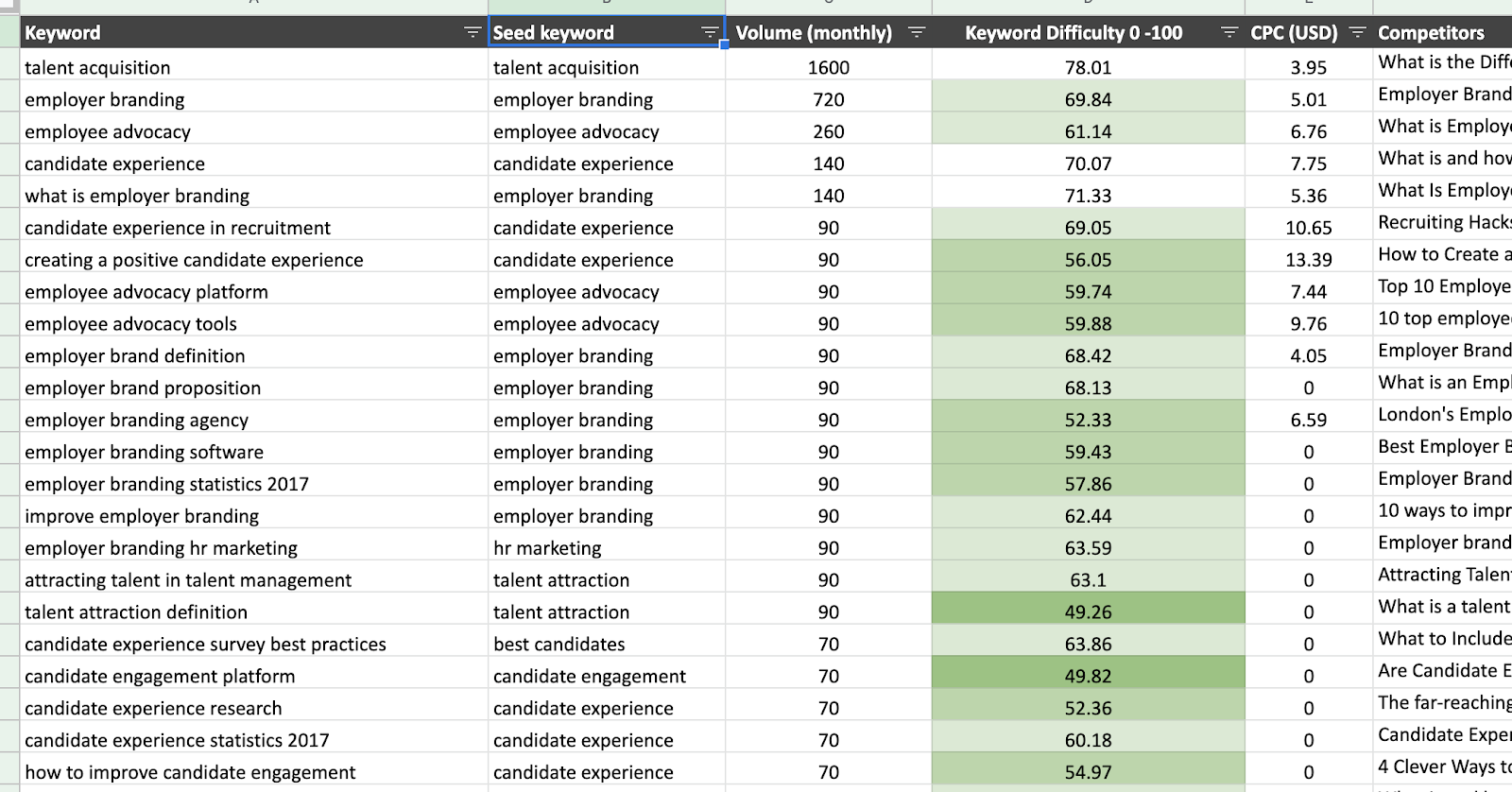
Manipulate the data how you wish.
We typically focus on two columns. The first is the ‘Volume” column, showing how many monthly searches there are on average for that term. The second is the “Keyword Difficulty” column, of course, showing you roughly how competitive it is.
Apply some conditional formatting
A useful thing to do at this stage is to apply some conditional formatting to at least one column, in this case, it’s the keyword difficulty column. Based on what we know, we would tend to say anything below 60% is fair game, below 50% is great and below 40% is gold dust. Obviously the more relevant the term the higher the difficulty, but sometimes there are terms that slip through the gaps – these are the ones to focus your content on marketing on, to begin with.
In this example below “document management consulting services” is a term with very low difficulty and around 40 searches a month on average (UK). This is a solution keyword, someone is looking for this service, by optimising a landing page about this product or service for this keyword you are likely to capture some of this highly relevant traffic.

Select your target keywords
Once you have a list of keywords you need to construct a rough content strategy based on them. At this point, it’s worth mentioning that the keyword research you do should be loosely based around one topic in the first place. For example “digital marketing strategy” may be the main term but your research would be around lots of relevant and related topics that link back into this main piece of content (Pillar/cornerstone).
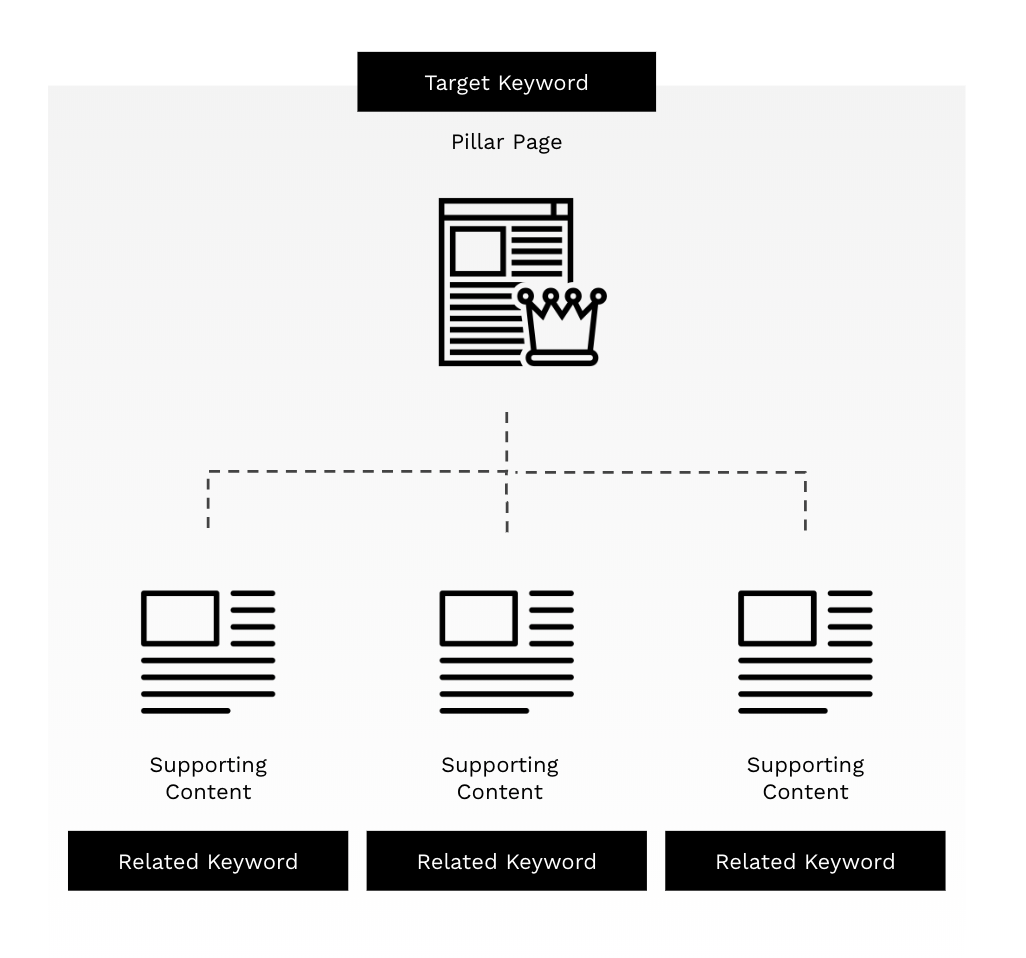
We organise our own content in an Airtable (because we like pretty colours). This way we can group content by the category, these are the same categories we use in WordPress to tag and group our content, this is then used in the URL as you can see below.

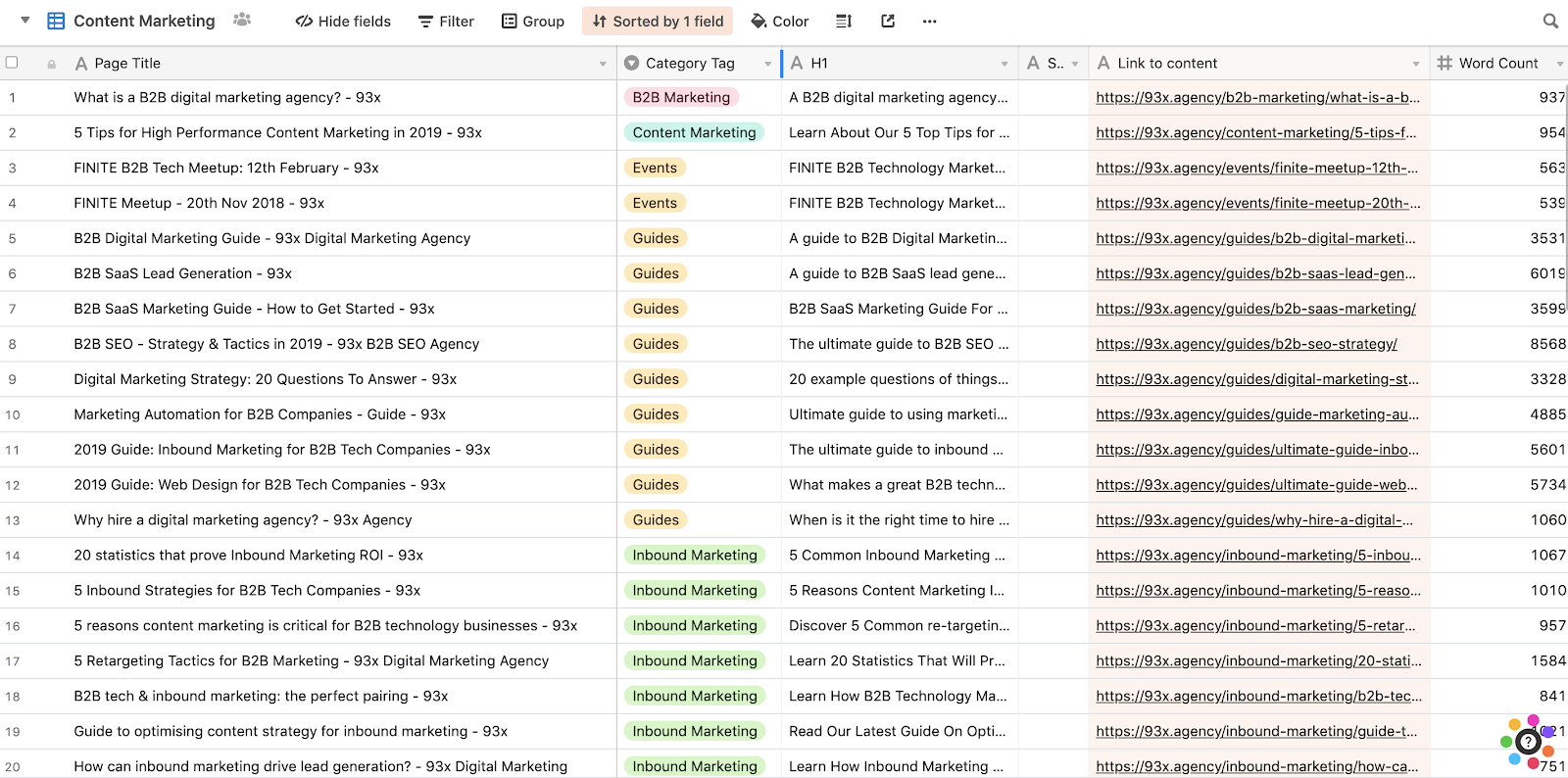
This is what I call a pragmatic approach to produce B2B content, and this for us is 90% of what B2B SEO is all about. Yes, there are other aspects like gaining high authority links to your website and by having a website built from a technically sound point of view, but we think you can also gain links naturally through producing really useful content for small audiences that will link to you as part of their own content marketing and SEO efforts.
Whether you call it inbound, content or SEO, it doesn’t matter. This tactic works. It doesn’t work for everybody, of course, nothing ever does. It really depends on your market, but you’ll get an idea pretty quickly based on the results of the research whether or not there is enough to go on.
Using Google Trends to find new topics
Using Google Trends is another way to do the same thing, I guess the difference is you are trying to get in early on new topics that don’t have a lot of content before people start writing loads on them so that’s something worth looking into aswell.
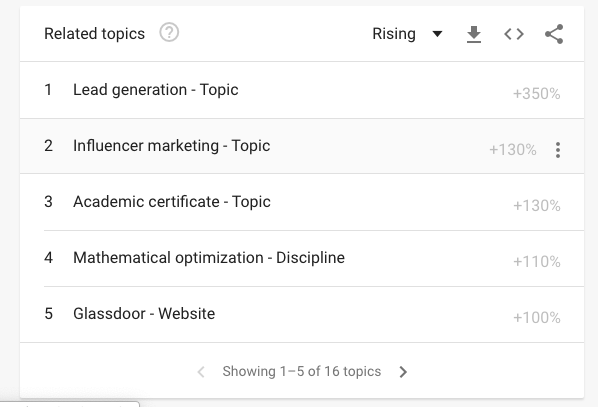
Be more useful to the internet
That’s what I would say if I had to sum it up really. Find areas where people haven’t contributed useful content and aim to make the best piece of content you can in a reasonable time frame. You can always come back and add to it later too.
Think of what your category or niche is as a business and focus on that with your keyword research. For example the top-level category for us would be a marketing agency, but thats way to broad, topics about how to be a better marketer are way to general. So, next level is digital marketing agency, again, too broad, digital marketing topics in general are relevant for us but we are likely to get lots of irrelevant traffic when they realise we specialise in B2B.
Next, B2B digital marketing agency, closer, we can write content around that and it will be relevant, but how about B2B digital marketing agency for software companies. Now that’s a long-tail, niche search query, but it means when someone is really looking for it, we’ll show up. And when we write content specifically relating to our service (like this article), it’s highly relevant to our audience and hopefully useful!
